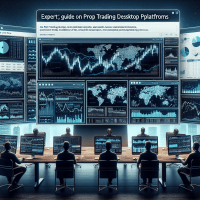Mastering the Prop Trading Application Process: Proven Strategies for Success
Prop trading firms offer ambitious traders the opportunity to leverage their skills and trade with firm capital. However, entering this competitive world requires a well-prepared application, mastery of backtesting techniques, and advanced risk management. In this guide, we demystify the prop trading application process, providing detailed strategic insights, tool comparisons, and practical case studies for both emerging and experienced professionals in the industry.
Understanding the Importance of the Prop Trading Application Process
In today’s advanced trading environment, the application process for proprietary trading firms transcends a mere submission of credentials. Firms demand clear evidence of robust strategy development, efficient risk management practices, and deep familiarity with automated backtesting tools. Whether you are a junior trader or a seasoned risk manager, understanding these elements is key to standing out. As prop trading application process criteria evolve, staying informed means you can align your skill set with what firms require.
Figure 1: Visual overview of an effective prop trading application including backtesting metrics and strategy validation.
Key Strategies for a Winning Application
Developing a Robust Trading Methodology
A successful prop trading application must clearly articulate your trading methodology. This includes a detailed explanation of your strategy’s theoretical framework, risk management rules, and the backtesting processes you use. For example, using Python with Backtrader for algorithmic strategy testing can show your technical prowess:
import backtrader as bt
class TestStrategy(bt.Strategy):
def __init__(self):
self.dataclose = self.datas[0].close
def next(self):
if not self.position:
if self.dataclose[0] < self.dataclose[-1]:
self.buy()
else:
if self.dataclose[0] > self.dataclose[-1]:
self.sell()
cerebro = bt.Cerebro()
cerebro.addstrategy(TestStrategy)
cerebro.run()
cerebro.plot()
This snippet highlights your ability to automate trading decisions with code. Emphasize personalized data handling, stress-testing capabilities, and integration with risk management protocols in your application.
Mastering Advanced Backtesting Techniques
Backtesting is the cornerstone of any successful prop trading strategy. However, advanced traders must avoid common pitfalls including overfitting, survivorship bias, and look-ahead bias. Employ multi-stage backtests:
- Out-of-sample testing: Reserve a portion of historical data for testing to validate your strategy’s performance.
- Walk-forward optimization: Continuously recalibrate parameters based on recent data. This method reduces model overfitting by simulating real-time markets.
- Forward testing (paper trading): Confirm backtesting results before live deployment to gauge market dynamics in real time.
These practices are vital when presenting robust, realistic trading models during your prop trading firm application process.
Comparison of Leading Automated Backtesting Tools
When preparing your prop trading application, proficiency with advanced backtesting tools can set you apart. Below is a focused comparison of three widely recognized platforms:
| Tool | Backtesting Features | Data Quality | Integration Capabilities | Pricing & Use Cases |
|---|---|---|---|---|
| TradingView | Vectorized backtesting, script sharing, optimization capabilities | Extensive historical data across assets, real-time feeds | Robust API, wide integration with brokers | Subscription-based tiers; ideal for both retail and prop firms focusing on technical analysis. |
| MetaTrader 5 | Event-driven backtesting, tick data support, commission and slippage modeling | High-quality data for forex and CFDs | Broad broker integration, API for custom development | Cost-effective for individual trading, scalable for prop firms with team collaboration features. |
| NinjaTrader | Robust simulation, stress testing, scenario analysis | Rich asset class coverage including futures, forex, and stocks | Easy API integration, compatible with several analytics platforms | Free basic version; advanced paid licenses support institutional prop trading requirements. |
This detailed table reflects deep insights necessary for your prop trading application. Internal links to further reading, such as our Backtesting Essentials guide, can add further value.
Managing Common Pitfalls and Optimizing Risk
Identifying and Mitigating Biases in Backtesting
One of the most challenging aspects of backtesting is the prevalence of biases that can misrepresent strategy performance. Traders must vigilantly monitor:
- Overfitting: Avoid tailoring your strategy too closely to past market conditions.
- Survivorship Bias: Ensure your data set includes truly failed strategies or assets that dropped out.
- Look-ahead Bias: Avoid using future data in current period calculations.
Effective risk management is crucial; measures such as setting strict stop-loss limits and optimizing position sizing based on metrics like the Sharpe ratio can mitigate severe drawdowns. Prop firms often target a Sharpe ratio above 1.0 and maximum drawdown limits of less than 15-20%. Detailed risk management processes should be outlined in your application to reflect discipline and strategic foresight.
Implementing Walk-forward Optimization
Walk-forward optimization offers a dynamic approach: it simulates how a strategy performs as market conditions evolve. Instead of a static backtest, parameters are continuously updated to reflect current market trends. This method requires iterative testing and is essential for prop firms aiming for adaptive trading models.
Case Study: Boosting Performance with Automated Backtesting
Consider a prominent proprietary trading firm that adopted advanced backtesting techniques using NinjaTrader and TradingView. They faced challenges such as model instability during market volatility and difficulty in scaling strategies for team use.
Challenge: The firm’s strategies were overfitted to historical data, resulting in subpar live performance. Moreover, manual parameter adjustments introduced delays in optimizations.
Solution: By integrating automated backtesting tools offering walk-forward optimization and scenario analysis, the firm automated parameter optimization. They employed out-of-sample testing and forward testing (paper trading) to ensure scalability and robustness of their strategies.
Results: The firm reported a 20% improvement in the Sharpe ratio, a reduction in maximum drawdown by 10%, and cut iteration times by half. This case study highlights how advanced backtesting tools and methodologies can directly enhance your prop trading application process performance.
Figure 2: Automated backtesting report from NinjaTrader displaying key performance metrics such as Sharpe ratio and drawdown, crucial for prop trading evaluations.
Regulatory Compliance and Industry Benchmarks in Prop Trading
In addition to strategy and tool mastery, regulatory compliance plays a significant role in the prop trading application process. Familiarity with frameworks like MiFID II, ESMA regulations, and NFA rules is essential. Firms demand transparency in risk procedures and automated reporting features for compliance and audit purposes. Including a compliance checklist in your application not only demonstrates readiness but also builds trust with potential employers.
Key Regulatory Considerations
Ensure your trading strategy addresses:
- Accurate reporting and transparency of risk metrics.
- Adherence to local and international trading regulations.
- Clear documentation around stress testing and scenario analyses.
Integrating Forward Testing for Live Deployment
Before fully deploying a strategy, forward testing via paper trading rounds is crucial. This phase allows you to validate your backtested results in real market conditions. Maintain a log of performance metrics and adjustments made during forward testing, which can be used as a reference in your application.
Best Practices for Effective Forward Testing
- Monitor key metrics such as profit factor, Sharpe ratio, and drawdown on a daily basis.
- Implement automated alerts when performance deviates from backtested expectations.
- Iterate strategy adjustments quickly to align with market shifts.
Pro Tips and Industry Insights
Pro Tip: Align your automated strategy simulations with economic events. This alignment can help identify periods when typical patterns break, ensuring your model is robust even during unpredictable market moves.
Next Steps and Final Recommendations
To further excel in your application to a prop trading firm, refine your backtesting processes and document your performance improvements meticulously. For a detailed checklist on risk management and strategy validation, download our comprehensive Risk Management Checklist. Additionally, explore our Prop Firm Compliance Guide for insights on meeting regulatory standards.
As of October 2023, staying updated with both market trends and regulatory shifts is imperative. A well-documented application that includes technical sophistication, risk discipline, and transparent reporting will significantly increase your chances of success.
Final Thought: Approach the prop trading application process as a continuous journey of testing, learning, and adapting. Your ability to integrate advanced backtesting, risk management, and compliance insights will set you apart in a competitive field.







